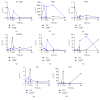The Lymphotoxin β Receptor Is Essential for Upregulation of IFN-Induced Guanylate-Binding Proteins and Survival after Toxoplasma gondii Infection
- PMID: 28845089
- PMCID: PMC5563413
- DOI: 10.1155/2017/7375818
The Lymphotoxin β Receptor Is Essential for Upregulation of IFN-Induced Guanylate-Binding Proteins and Survival after Toxoplasma gondii Infection
Abstract
Lymphotoxin β receptor (LTβR) signaling plays an important role in efficient initiation of host responses to a variety of pathogens, encompassing viruses, bacteria, and protozoans via induction of the type I interferon response. The present study reveals that after Toxoplasma gondii infection, LTβR-/- mice show a substantially reduced survival rate when compared to wild-type mice. LTβR-/- mice exhibit an increased parasite load and a more pronounced organ pathology. Also, a delayed increase of serum IL-12p40 and a failure of the protective IFNγ response in LTβR-/- mice were observed. Serum NO levels in LTβR-/- animals rose later and were markedly decreased compared to wild-type animals. At the transcriptional level, LTβR-/- animals exhibited a deregulated expression profile of several cytokines known to play a role in activation of innate immunity in T. gondii infection. Importantly, expression of the IFNγ-regulated murine guanylate-binding protein (mGBP) genes was virtually absent in the lungs of LTβR-/- mice. This demonstrates clearly that the LTβR is essential for the induction of a type II IFN-mediated immune response against T. gondii. The pronounced inability to effectively upregulate host defense effector molecules such as GBPs explains the high mortality rates of LTβR-/- animals after T. gondii infection.
Figures









Similar articles
-
Lymphotoxin β Receptor: a Crucial Role in Innate and Adaptive Immune Responses against Toxoplasma gondii.Infect Immun. 2021 May 17;89(6):e00026-21. doi: 10.1128/IAI.00026-21. Print 2021 May 17. Infect Immun. 2021. PMID: 33753412 Free PMC article.
-
Immediate lymphotoxin beta receptor-mediated transcriptional response in host defense against L. monocytogenes.Immunobiology. 2008;213(3-4):353-66. doi: 10.1016/j.imbio.2007.10.011. Epub 2007 Dec 31. Immunobiology. 2008. PMID: 18406380
-
A cluster of interferon-γ-inducible p65 GTPases plays a critical role in host defense against Toxoplasma gondii.Immunity. 2012 Aug 24;37(2):302-13. doi: 10.1016/j.immuni.2012.06.009. Epub 2012 Jul 12. Immunity. 2012. PMID: 22795875
-
The Lymphotoxin Network: orchestrating a type I interferon response to optimize adaptive immunity.Cytokine Growth Factor Rev. 2014 Apr;25(2):139-45. doi: 10.1016/j.cytogfr.2014.02.002. Epub 2014 Mar 12. Cytokine Growth Factor Rev. 2014. PMID: 24698108 Free PMC article. Review.
-
LTβR Signaling Controls Lymphatic Migration of Immune Cells.Cells. 2021 Mar 29;10(4):747. doi: 10.3390/cells10040747. Cells. 2021. PMID: 33805271 Free PMC article. Review.
Cited by
-
Lymphotoxin β Receptor: a Crucial Role in Innate and Adaptive Immune Responses against Toxoplasma gondii.Infect Immun. 2021 May 17;89(6):e00026-21. doi: 10.1128/IAI.00026-21. Print 2021 May 17. Infect Immun. 2021. PMID: 33753412 Free PMC article.
-
Cyclooxygenase (COX)-2 Inhibitors Reduce Toxoplasma gondii Infection and Upregulate the Pro-inflammatory Immune Response in Calomys callosus Rodents and Human Monocyte Cell Line.Front Microbiol. 2019 Feb 12;10:225. doi: 10.3389/fmicb.2019.00225. eCollection 2019. Front Microbiol. 2019. PMID: 30809216 Free PMC article.
References
-
- Ehlers S., Hölscher C., Scheu S., et al. The lymphotoxin beta receptor is critically involved in controlling infections with the intracellular pathogens mycobacterium tuberculosis and Listeria monocytogenes. Journal of Immunology. 2003;170(10):5210–5218. doi: 10.4049/jimmunol.170.10.5210. - DOI - PubMed
MeSH terms
Substances
LinkOut - more resources
Full Text Sources
Other Literature Sources

